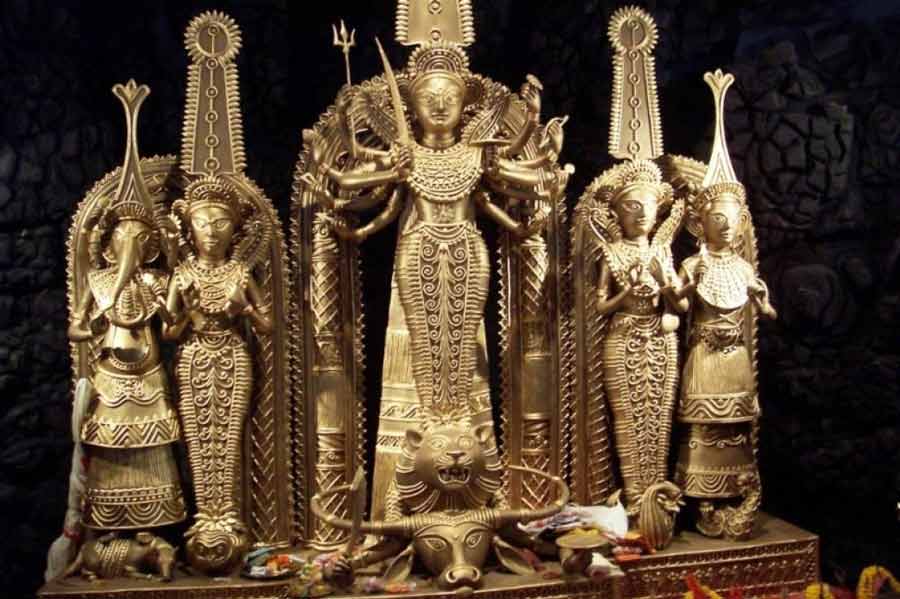
Durga, Dhokra art, West Bengal
When we look at Durga's image in her desperate battle against the ferocious Mahishasura, we may also notice that her family members appear rather
disinterested. Handsome Kartik does not lift his weapons; Ganesh appears almost smiling; Lakshmi holds on to her jhampi more tightly and Saraswati looks
pretty with her veena. To understand this strange situation, we have to turn to history, first from other countries and then closer at home.
The goddess who rode the lion was well known in the Middle East and the Mediterranean region for millennia, as Ishtar in Mesopotamia, Astarte in Greece and
Cybele in Troy. Cybele was, in fact, so powerful that she was taken away to Rome in 204 BC from Turkeys' Anatolia and
Roman emperors worshipped her as the "great mother of the gods",
Magna Mater Deium. Till the 4th century, her temple was located where the holy Vatican stands now. It is quite interesting to note that her worship was
known as “baptism in the blood of the sacred bull", as it is so close to Durga spilling the blood of the buffalo. She was also referred to as the “goddess
of caves” which reminds us of Durga's origins from the words "inaccessible” or Durgam. According to Barbara Walker, "she personified the fighting spirit of
a mother protecting her young". The Babylonian goddess Ishtar who rode a lion was referred to in the Bible by Prophet Jeremiah as Esther, the Queen of
Heaven. A prayer as "she who dost make the green herd to sprint up" reminds us of Shakambari or Durga as the goddess of vegetation.
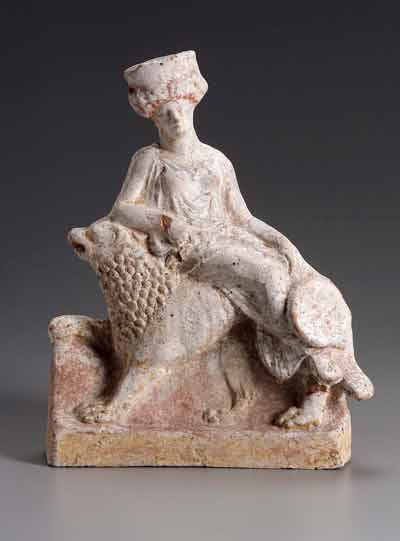
Statuette of Cybele, mother of the gods, and queen of nature.
Rides a lion; tympanum hangs from left hand.
Lion’s mane yellow; red stripes on base. Ceramic painted
in tempera colors: red surives on hair, lips, and background.
Terracotta, Greek Late Classical Period about 400 B.C. Thebes,
Boiotia, Greece. MFA Boston, Francis Bartlett Donation of 1900
The mother goddess was also quite visible in Europe and Africa since times immemorial, and we see her in plenty in the Indus Valley. But she appears less
in the Vedic period, from which we get no figurines or material evidence. The Satapatha and Taittiriya Upanishads, however, refer to "Ambika" but it is
only in the Sutras of Boudhayana and Sankhayana that the name 'Durga' appears, for the first time. The Epics have stray references to Devi, Sakti, etc, but
the ten-armed warrior goddess was not their focus area. The Bhisma Parva mentions Arjuna worshipping Durga and there are references to Skanda-Kartikeya
killing Mahishasura. A few Puranas mention Durga, but it was only when the
Devi Mahatmya section of the Markandeya Purana glorified Durga's victory over Mahishasura that she was legitimately inducted into the Hindu pantheon. Soon,
the old Vedic triad of “Brahma, Vishnu and
Maheshwar” gave way to “Vishnu, Siva and Devi” and Brahma was retired to Pushkar. Even the great Vedic god, Indra is remembered as a suffix to Hindu names,
like Dharmendra or Narendra, as his temples disappeared.
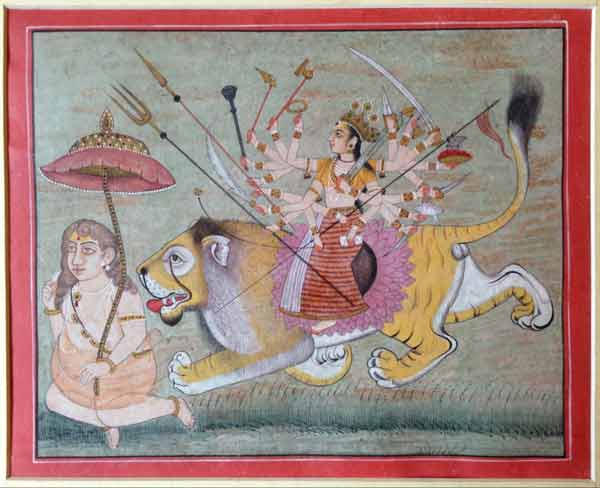
Rare Indian miniature painting of Durga as Ishwari from Juniya, Rajasthan India. Circa 1700
Sculptures depict her well before the Devi Mahatmya, but not in the present Dasha-bhuja or Ashta-Bhuja forms. A terracotta image from the 1st century found
at Nagar in Rajasthan is perhaps the earliest icon and it has the Mahisha, the lion and the trishul, but Durga has only four hands. Another set of six
Kushana period statues in the Mathura Museum has the trishul and the buffalo, but no lion. J N Banerjea has described in detail the mature images of
Mahishasura-Mardini of the Gupta period but we wonder why the first major text on Durga came only after the Gupta period. Texts and sculptures in Bengal
portraying different images of the goddess started appearing at a little later, but it took several centuries for the resplendent image of the present day
to be crafted together. Vernacular Ramayans like Kamban’s Tamil one of the 12th century and Krittibasa’s Bengali version in the 15th century
weaved together disparate popular perceptions about the warriorgoddess and Rama’s Akal-bodhana into clear yet definitively regional narratives.
The timing of the Durga Puja in Ashwin-Kartik coincided with the ripening of the Aus crop that was most prevalent in this region for centuries before the
Aman varieties took over. About the buffalo, my submission is that it had to be slaughtered and driven away from its natural habitat in the low-lands by
the emerging peasant groups, as they needed for more land for cultivation. In America, the white colonists wiped off lakhs of ‘bisons’ from the Prairies to
clear land for farming and also killed the bison-centric 'Red Indians’ as well. Durga as Mahishasura-Mardini may therefore have been a sacred legitimation,
especially for Zamindars like Raja Krishna Chandra and Kansa Narayan who extended agriculture and their revenues.
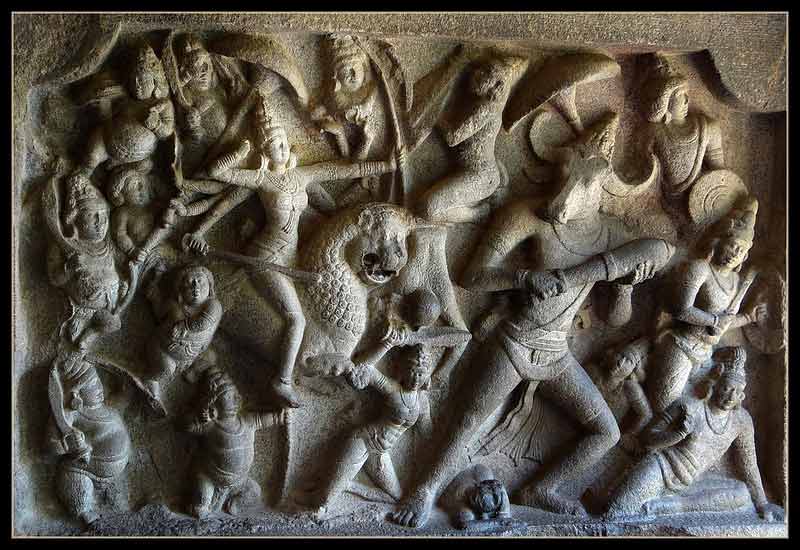
Mahishasura Mardini panel in Mahishasura Mardini Cave, Mahabalipuram, Pallava period
R P Chanda and P C Bagchi have argued that the Simha-vahini Durga was imported into Bengal from outside after the Gupta period but others argue that she
has local roots. In a sense, both are correct as there are strong Bengali elements and external components. In several images of Durga we see a strange
‘mount’ that looks more like the iguana (godhika or gosap) of Kalketu's Chandi rather than the more sanskritised lion. Even till the 19th
century, patuas and chitrakars in Bengal had difficulty in depicting the lion as they had never seen one in their lives. In north India, however, she
continues to ride the Royal Bengal tiger, how strange!
Durga appears with six or eight arms is part of the Shivaite religion in several places of Indonesia like Borobudur, Surabaya, Bandung and Prambanan. An
inscription in Java mentions that King Airlangga worshipped Durga to win her support before a battle. During the height of Majapahit power in Java, Durga
was worshipped as the fierce protector and her cult became even stronger in the 15th and 16th centuries. But as Islam took over,
Durga was relegated to cremation grounds and cemeteries and therefore moved eastward to Hindu Bali, where she got more respect. Durga is also known in some
other countries where the Hindu religion was exported.
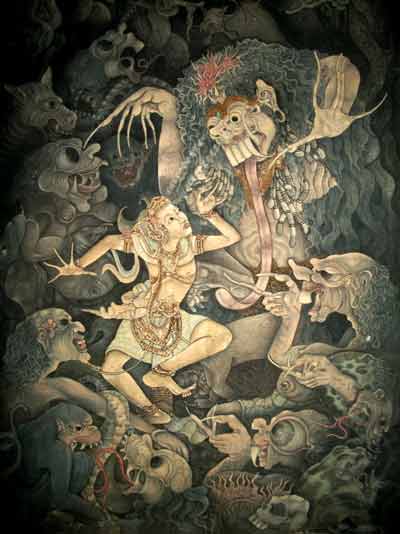
Betari Durga and Sahadewa, Balinese painting
To return to Durga's children, it is clear that they were superimposed later on by the ruling patriarchy, in order to domesticate the independent warrior
goddess and to remind her of her maternal obligations. A 12th century image from Dakshin Muhammadpur in erstwhile Comilla shows Ganesha and Kartikeya along
with her, but the daughters are not there. Historians like R D Bandyopadhyay, N K Bhattasali, J N Banerjea, S K Saraswati and Enamul Haque tried their
best, but could not locate a single ancient sculpture of Durga with all her four children. B N Mukherjee, however, claimed that there is one exception in
Rajshahi. No serious religious texts mention that how they came into Bengal's post-Zamindari iconography and it can be assumed that Menaka and Giri-raj's
vatsalya for their daughter Uma, that ultimately won the round in “containing” Durga. She visits her original home just once a year, and Bengalis dote over
this “darling daughter”. But how could she leave behind her own children and also the poor bleeding Mahishasura, who is thus dragged all the way to her
parents! Poets like Dasharathi Ray and Rashikchandra Ray have thus described so vividly Menaka's total bewilderment at seeing her sweet daughter coming
home, straight from battle, totally unrecognisable. All contradictions cannot be wiped off.
Jay Maa Durgaa!